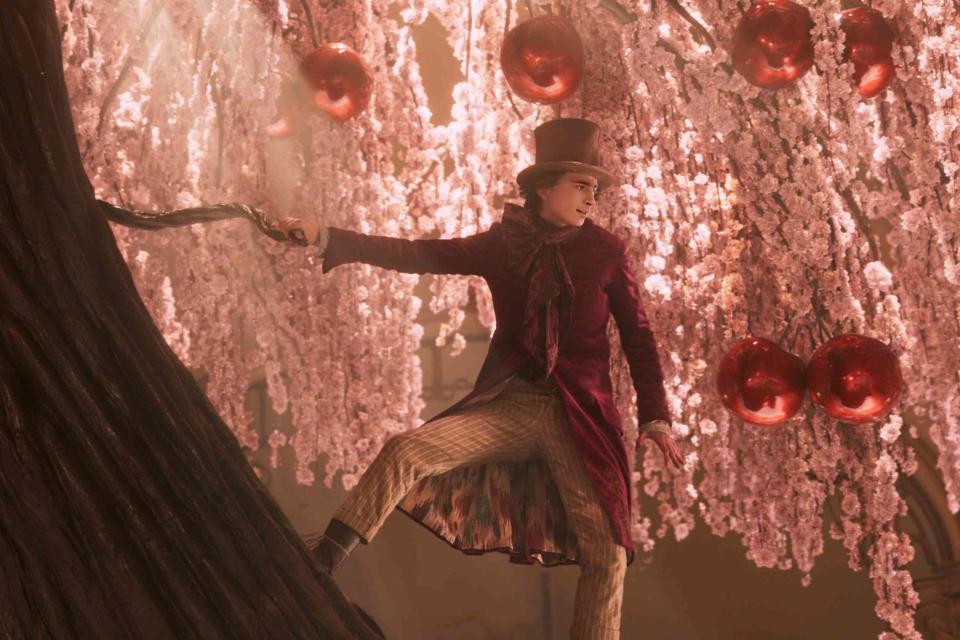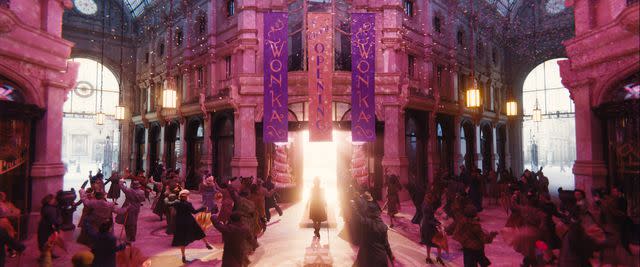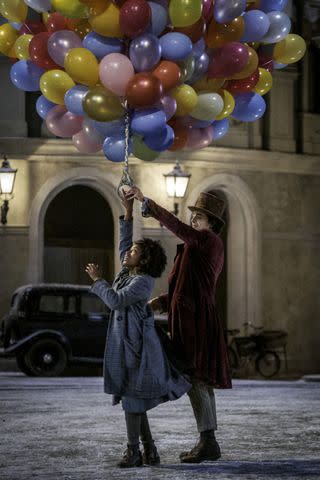'Wonka' Has a PG Rating—But Is It Appropriate for Younger Kids?
The prequel is a magical journey with life lessons for teens, tweens, and kids.

Warner Bros.
Fact checked by Sarah Scott
I didn’t plan on seeing Wonka at all. It hadn’t crossed my mind until my teenage daughter mentioned that she just had to go see it. Shocked by her newfound interest in the film, I did my research and discovered that Timothée Chalamet would be playing the title role of Willy Wonka.
As a millennial parent, I was not aware of the current Chalamet craze among tween and teen girls. At least that was the case until the chatter of going to see the movie became a major topic of discussion in my own home. Amused that my daughter and her friends were planning to go to a movie just to stare at the lead actor, I decided to take them to see if the movie could live up to the hype.
To my surprise, Wonka exceeded not only my expectations in many ways but also the teen girls that I brought along with me. Under the direction of Paul King, Wonka is the prequel to both versions of Charlie and the Chocolate Factory. It beautifully brings to life the chocolate-filled, fantastical world of Willy Wonka through ornate costume design, stunning production sets, excellent casting choices, and many powerful and positive themes.
There’s a wonderful musical theater element that lovers of the performing arts and theater will truly appreciate, and the cast can sing well, including Chalamet. Parents and guardians who value seeing ethnic and cultural diversity will be pleased to see a diverse lead and ensemble cast.

Warner Bros.
The Themes of 'Wonka'
One of the sweetest surprises in Wonka is the on-screen chemistry and relationship between the young Wonka, and Noodle (Calah Lane)—a young, Black tween, who is a presumed orphan. Lane brings an innocence and sincerity to her portrayal of Noodle that is pleasing to see.
What makes the interaction between Wonka and Noodle so endearing is that the relationship is not romantic or rooted in physical attraction. Contrarily, their friendship and connectivity are pure, and centers on the reality that they are both yearning for their mothers.
The interactions between Wonka and Noodle carry the film in many scenes and share a message to both tweens and teens that there can be warm, genuine friendships in a film for kids and teens that does not include a love interest. When speaking with my daughter and her tween and teen friends, all of differing ethnicities and socioeconomic backgrounds, Noodle was their favorite character.

Warner Bros.
Poverty, illiteracy, exploitation by the wealthy, searching for identity and belonging, and overindulging in sweets are some of the major themes in Wonka. There are many themes and opportunities to have open discussions and conversations with both kids and teens about real-life issues.
Wonka is poor, and the only son of a single mother, yet he has a generous heart and a desire to see others happy and fulfilled. However, that’s not the case for those in power within the film. The Chief of Police (Keegan-Michael Key) is corrupt and can be easily manipulated by the elite villains.
Wonka is in poverty, and he is a much more talented chocolatier than the wealthier chocolate makers. As a result of his vulnerability and lack of notoriety, those in power seek to exploit his skillset and even plot to destroy him. This narrative provides a wonderful opportunity to discuss with kids and younger teens the experiences of those in differing socioeconomic households.
Wonka is an older teen who can’t read. Yet, this does not deter him from trying to learn how. This is a great lesson to share with kids, tweens, and teens about having a growth mindset. It also can be an excellent segue into discussing how illiteracy can impact the poor, as well as marginalized communities.

Warner Bros.
Is 'Wonka' Appropriate for Younger Kids?
While Wonka is definitely appropriate for tweens and teens, ages 13 and up. Parents of younger kids need to know that it has a PG rating due to some mild violence, mild language, and some thematic elements.
Sexual Innuendos
There’s some light kissing and hugging among adults, as well as light flirting between Mrs. Scrubbit and Bleacher. Two adults willfully try to seduce one another, and an adult male wears extremely short shorts to showcase his knees to his female counterpart.
Mild Violence
There is some mild violence in the film but nothing graphic. In one scene, Willy Wonka and Noodle are placed in a chocolate-filled room to die (but they do not die). There’s an explosion meant to harm Willy Wonka, but he escapes. In this period piece, servants are also forced into labor.
There is also talk of death and a mother dying, a tween girl is at times locked away, and there are guns in a few scenes, though no one is harmed.
Mild Language and Themes
There’s some joking and commentary about obesity and being overweight. There’s an aversion to the word “poor” and the use of the word “Damn”. And, at times, those who are poor are treated as less than, and with an attitude of otherness. But again, this can create an opportunity to have a conversation with your child about these themes.
For more Parents news, make sure to sign up for our newsletter!
Read the original article on Parents.

